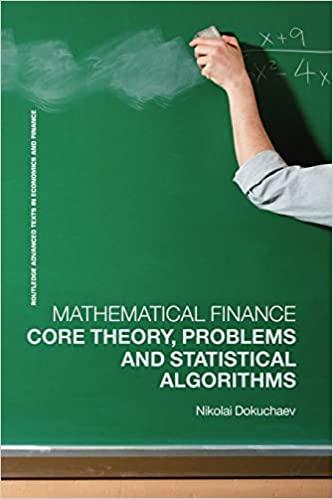a. Consider two stocks that have returns with the following covariances with the market return: [0.001,0.003], and the stock market has an expected return equal to 0.05 and variance 0.004. The risk-free rate is equal to 0.01. i. Compute the CAPM for the two stocks. Plot the Security Market Line and on that line show each of the stocks and the market portfolio. (20 marks) ii. Suppose that you instead observe an expected retum for the two stocks for both equal to 0.01. What would you conclude? Are the stocks overvalued/undervalued according to the CAPM? (20 marks) iii. Would the expected returns in part (ii) change in equilibrium? If so, how? (10 marks) b. Suppose that you have run a regression as follows: Y=+X, where Y=E(R)Rf, and X=E(Rm)Rf, and E(R) is the expected return on the stock. Suppose that you have obtained the estimates of and , and the corresponding t-statistics that are small and fail to reject the null hypothesis of zero estimates. What would you conclude about the CAPM for your stocks? (25 marks) c. What is the empirical evidence for the implications of the CAPM in explaining cross-sectional stock returns. Use explicit examples where possible. a. Consider two stocks that have returns with the following covariances with the market return: [0.001,0.003], and the stock market has an expected return equal to 0.05 and variance 0.004. The risk-free rate is equal to 0.01. i. Compute the CAPM for the two stocks. Plot the Security Market Line and on that line show each of the stocks and the market portfolio. (20 marks) ii. Suppose that you instead observe an expected retum for the two stocks for both equal to 0.01. What would you conclude? Are the stocks overvalued/undervalued according to the CAPM? (20 marks) iii. Would the expected returns in part (ii) change in equilibrium? If so, how? (10 marks) b. Suppose that you have run a regression as follows: Y=+X, where Y=E(R)Rf, and X=E(Rm)Rf, and E(R) is the expected return on the stock. Suppose that you have obtained the estimates of and , and the corresponding t-statistics that are small and fail to reject the null hypothesis of zero estimates. What would you conclude about the CAPM for your stocks? (25 marks) c. What is the empirical evidence for the implications of the CAPM in explaining cross-sectional stock returns. Use explicit examples where possible







